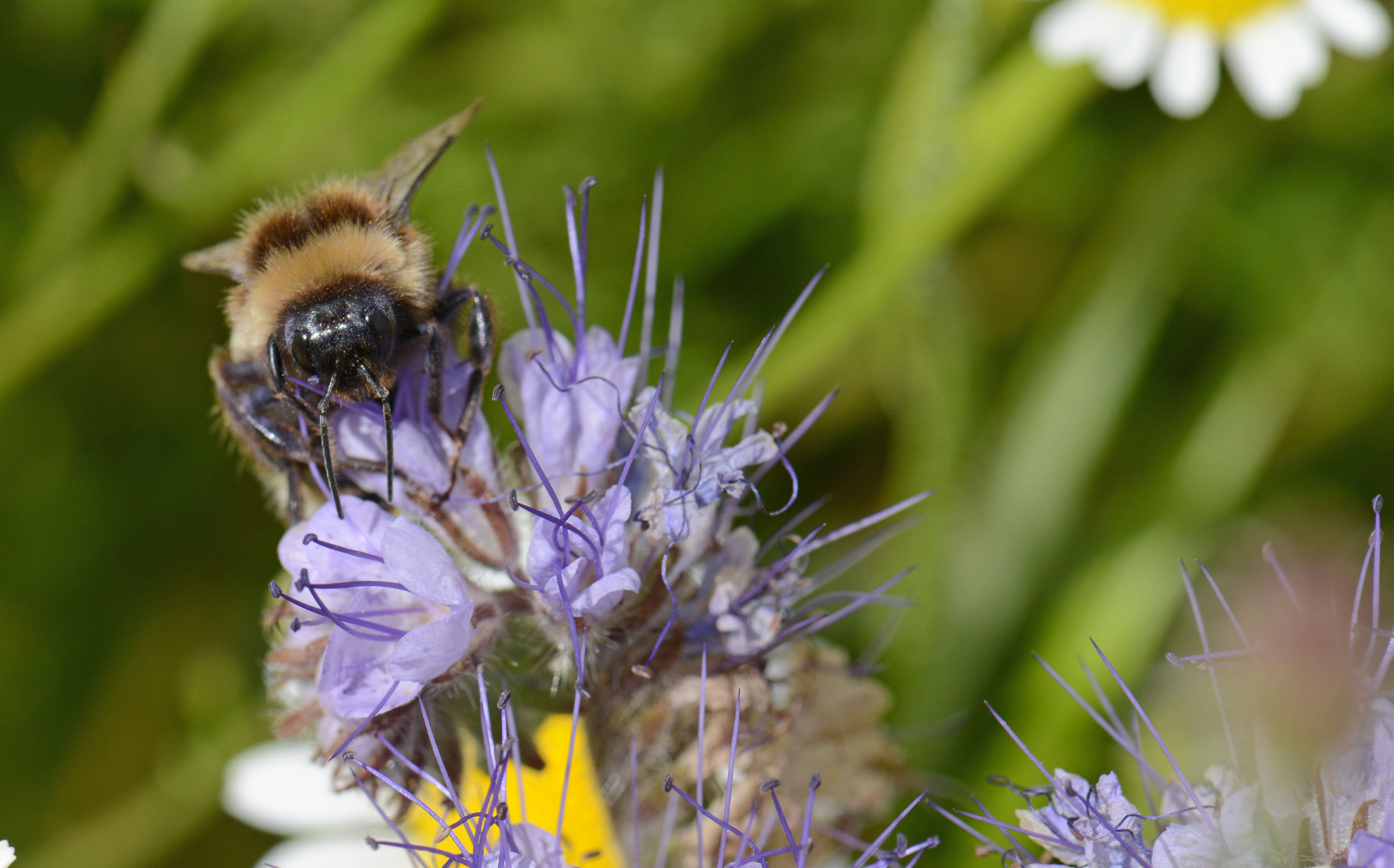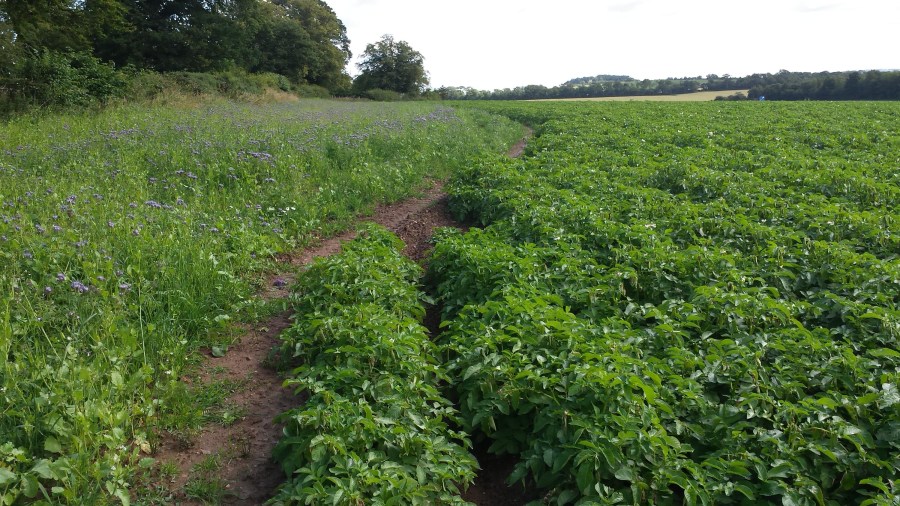Potato growers are helping promote biodiversity by planting green headlands around crops. CPM reports the latest findings which suggest that several predators are thriving.
The margins host a very high proportion of predators.
By Lucy de la Pasture and Rob Jones
At a time when headlines are warning of an insect apocalypse, new research has found potato and vegetable growers are providing a hugely valuable habitat resource and insect species are thriving.
Monitoring of green headlands around highly productive fields in East Anglia last year has identified huge insect numbers and a vast array of biodiversity. Independent ecologist, Paul Lee, assessed over 36,000 invertebrates, collected from sweep netting on six farms on just two occasions over the summer 2018. Some green headland margins contained up to 55 different species.

Last summer favoured bee and fly species which tend to suffer during cool, wet summers.
Identifying 199 different insect species overall, it was the beetles and bugs that dominated the mixtures, he reports. “But a number of insect groups that had suffered in successive cool wet summers, did particularly well in the warm dry conditions, particularly the flies and bee species.”
Some solitary bee species have been increasing in both number and range across the UK over the past decade, benefitting from the trend to warmer temperatures. “Last year’s record temperatures and prolonged dry conditions were particularly favourable for some solitary bees, and we have seen the numbers increase accordingly,” he points out.
Solitary bees are typically far more efficient as pollinators, compared with honey bees. The hairy bodies of some species can transfer dry pollen between flowers more effectively. Studies have indicated that, as a pollinator, a solitary bee is three times more effective than a honey bee, and typically visits in excess of 100 times more flowers a day.
The Green Headland initiative was instigated by Syngenta and ASDA, in association with grower supply group, IPL, and specialist seed suppliers, Kings. One of the key highlights of the monitoring has been repeated sightings of the squat furrow bee – present on half of the assessed farms across the region. Classified as nationally scarce, the solitary bee species has been doing well, moving further north and expanding its range.
The squat furrow bee was one of the exciting finds on Geoffrey Mayhew Farms, based at Pond Farm, near Erwarton, Ipswich – winners of the Syngenta Operation Pollinator Green Headlands Biodiversity Award 2018.
With between 41 and 55 different species in each of the farm’s headland that were assessed, the biodiversity was consistently high. That included a five-banded digger wasp, which is nationally rare and a key target for action to enhance biodiversity but has a strong foothold in Suffolk.
Importantly the wasp can give positive control of crop pests, by hunting and collecting weevils, which it buries and uses as a food source for its young. It was one of a large number of predatory insects identified in the green headland margins, which can beneficially help to reduce pest pressure on crops.
Geoff Mayhew highlights that growing the brassica and phacelia-rich green headland mix brings a range of benefits to the farm, including plant biomass and rooting to protect and enhance soil structure on the headlands, as well as capturing nutrients and retaining them in the field, where they can be utilised by the following crop.
“Environmentally it delivers a real positive boost for the farm and, since we are growing the mix on previously uncropped headland, there’s no loss in productivity from the field,” he says. “It’s also a great attraction for visitors to the farm.
“We could now look to integrate each year’s green headlands with other environmental features on the farm, as well as the initiatives of other farmers in the area, to coordinate a truly exceptional and huge ecological resource for the Suffolk area, within a highly productive farming landscape.”
Syngenta environmental specialist, Dr Max Newbert, reinforced the role of the green headlands for their agronomic benefits. “The margins host a very high proportion of predators, compared with potential pest species. That could significantly add to levels of biocontrol and bring beneficial predators into the crop.”
He highlights the monitoring had identified no major pest species hiding in the margins, and few aphids that could risk the spread of virus into crops, particularly carrots and potatoes.
“In fact, the green headlands may have a beneficial function in delaying aphid migration into the crop, during which time the pests would lose the ability to transfer any non-persistent virus they may be carrying.”
Max reported his studies last year, that where the mix was planted around carrot fields there was a 70% reduction in visible virus effects, compared with no margin – albeit with a relatively low level in all the crop and a low risk year.
“The headland had a significantly higher biomass of insect life and, whilst the crop received the same insecticide programme, it did demonstrate the potential for this IPM approach to give results over and above the conventional programme.”
He also believes that it could offer a viable Integrated Pest Management (IPM) approach to carrot root fly control, as sampling found no Apiaceae species in the green headland mix or build-up of carrot root fly.
Dr Chris Brown, ASDA senior director of sustainable sourcing adds, “It’s incredibly exciting and positive to see the results of independent monitoring that validates the benefits of growers’ good practice and enhancing the farmland environment.
“Green Headlands is a genuinely sustainable initiative that can offer a cost effective and efficient solution to make better use of land, to improve the environment and to protect soil and water.
“We invest a lot of time and effort in assuring the sustainability of food production; this initiative highlights the efforts of UK growers to work towards increasing biodiversity and protecting resources.”
First feel for Zorvec
The newest blight fungicide on the market didn’t get much of a chance to prove itself last season. Many growers didn’t feel the need to apply Zorvec Enicade (oxathiapiprolin), in what was generally a low-pressure season.
One company that did recommend Zorvec was Environmental Crop Management (ECM) in Cheshire. Managing director Peter Clare, says he was convinced of the properties of Zorvec long before it was launched having closely watched its progress in trials.
“Our potato growers operate across Cheshire and Lancs, which is a wet area and experiences many blight events. Because of this, the fungicide programme to protect crops from late blight is taken very seriously.
“We see some fearsome strains and, given that quality is king for many of the markets our clients supply, we tend to be quite robust.”
ECM’s agronomists are responsible for about 2000ha of potatoes, many of which are destined for the crisping market. Last year’s prolonged hot, dry weather meant some growers reduced their blight fungicide investment, which Peter thinks was a mistake.
His company advised the maximum four Zorvec applications throughout the growing season. Each application utilised the full 10-day interval, which Corteva promote as one of the unique traits of the new chemistry, adding a full three days to the industry standard interval.
“There were two reasons protecting the crop was especially important last year,” says Peter. “Potato prices on the free market were very high, so any grower who suffered losses was going to pay a significant financial penalty. The second was that in a year of poor yields, growers were struggling to fulfil contracts but with the blight programme we employed none of our growers had a problem with that.”
Corteva acknowledges there were some growers who did not take up the option of ten-day spray intervals, many of which linked this to well-established seven-day work schedules. But Peter says it was an ‘easy decision’ for him to make.
“The question was raised as to whether it was too dry for blight to become a real issue, but we have a lot of potatoes grown on close rotations and you only need a shower of rain to create a blight period, so we took the decision that it was too valuable a crop,” he says.
“It was a no-brainer for those who were irrigating too. We applied it in a mix with trace elements to help keep the crop alive, so we managed to kill two birds with one stone.”
Others in the region weren’t so fortunate, he claims. “There were examples of growers beginning to harvest and realising there was blight there, which was a disaster for them. They either reduced the programme or decided not to spray because of the dry weather and unfortunately ended up paying the price. We’ll definitely be taking a similar approach to last year during this season.”




